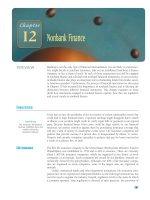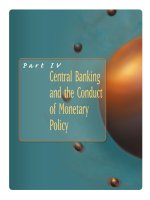Money banking and the financial system 1e by hubbard and OBrien chapter 11
Bạn đang xem bản rút gọn của tài liệu. Xem và tải ngay bản đầy đủ của tài liệu tại đây (510.09 KB, 49 trang )
R. GLENN
HUBBARD
ANTHONY PATRICK
O’BRIEN
Money,
Banking, and
the Financial
System
© 2012 Pearson Education, Inc. Publishing as Prentice Hall
CHAPTER
11 Investment Banks, Mutual Funds,
Hedge Funds, and the Shadow
Banking System
LEARNING OBJECTIVES
After studying this chapter, you should be able to:
11.1
Explain how investment banks operate
11.2
Distinguish between mutual funds and hedge funds and
describe their roles in the financial system
11.3
Explain the roles that pension funds and insurance
companies play in the financial system
11.4
Explain the connection between the shadow banking system and
systemic risk
© 2012 Pearson Education, Inc. Publishing as Prentice Hall
CHAPTER
11 Investment Banks, Mutual Funds,
Hedge Funds, and the Shadow
Banking System
WHEN IS A BANK NOT A BANK? WHEN IT’S A SHADOW BANK!
•During the financial crisis of 2007–2009, a variety of “nonbank” financial
institutions were acquiring funds that had previously been deposited in
banks, and they were using these funds to provide credit that banks had
previously provided. The newly developed securities they were creating
were not fully understood.
•A key issue for policymakers in dealing with the crisis was the role the Fed
should play in dealing with a financial crisis that involved many nonbank
financial firms.
•An Inside Look at Policy on page 338 discusses whether a panic in the
shadow banking system caused the financial crisis.
© 2012 Pearson Education, Inc. Publishing as Prentice Hall
Key Issue and Question
Issue: During the 1990s and 2000s, the flow of funds from lenders to
borrowers outside of the banking system increased.
Question: What role did the shadow banking system play in the
financial crisis of 2007–2009?
© 2012 Pearson Education, Inc. Publishing as Prentice Hall
4 of 49
11.1 Learning Objective
Explain how investment banks operate.
© 2012 Pearson Education, Inc. Publishing as Prentice Hall
5 of 49
What Is an Investment Bank?
Investment banking Financial activities that involve underwriting new security
issues and providing advice on mergers and acquisitions.
Investment bankers are involved in the following activities:
1. Providing advice on new security issues
2. Underwriting new security issues
3. Providing advice and financing for mergers and acquisitions
4. Financial engineering, including risk management
5. Research
6. Proprietary trading
Investment Banking
© 2012 Pearson Education, Inc. Publishing as Prentice Hall
6 of 49
Providing Advice on New Security Issues
• Firms turn to investment banks for advice on how to raise funds by issuing
stock or bonds or by taking out loans.
Underwriting New Security Issues
Underwriting An activity in which an investment bank guarantees to the
issuing corporation the price of a new security and then resells the security for
a profit, or spread.
Initial public offering (IPO) The first time a firm sells stock to the public.
• An investment bank typically earns 2% to 4% of the dollar amount raised in a
secondary offering (or seasoned offering).
• In return for the spread, the investment bank takes on the risk that it cannot
profitably resell the securities being underwritten.
Investment Banking
© 2012 Pearson Education, Inc. Publishing as Prentice Hall
7 of 49
Syndicate A group of investment banks that jointly underwrite a security issue.
• In a syndicated sale, a lead investment bank keeps part of the spread, and
the remainder is divided among the syndicate members.
• Once a firm has chosen the investment bank that will underwrite its
securities, the bank carries out a due diligence process, during which it
researches the firm’s value. The investment bank then prepares a
prospectus, which the Securities and Exchange Commission (SEC) requires
of every firm before allowing it to sell securities to the public.
• During the financial crisis of 2007–2009, investor confidence about the ability
of investment banks to gather information was shaken when investment
banks underwrote mortgage-backed securities that turned out to be very
poor investments.
Investment Banking
© 2012 Pearson Education, Inc. Publishing as Prentice Hall
8 of 49
Providing Advice and Financing for Mergers and Acquisitions
• Investment banks are very active in mergers and acquisitions (M&A). They
advise both buyers—the “buy side mandate”—and sellers—the “sell side
mandate.”
• When advising a firm seeking to be acquired, investment banks attempt to
find an acquiring firm willing to pay significantly more than the book value of
the firm.
• Advising on M&A is particularly profitable for investment banks because the
bank does not have to invest its own capital. Its only significant costs are the
salaries of the bankers involved in the deal.
Investment Banking
© 2012 Pearson Education, Inc. Publishing as Prentice Hall
9 of 49
Financial Engineering, Including Risk Management
• Financial engineering involves developing new financial securities or
investment strategies using sophisticated mathematical models.
• Derivative securities, used by firms to hedge, are the result of financial
engineering.
• Investment banks supply knowledge of financial markets to properly assess
the best way to raise funds by selling stocks and bonds, and construct risk
management strategies for firms in return for a fee.
• During the financial crisis, investment bank managers greatly
underestimated the risk that the prices of these derivatives might fall if
housing prices declined and people began to default on their mortgages.
Investment Banking
© 2012 Pearson Education, Inc. Publishing as Prentice Hall
10 of 49
Research
• Investment banks assign research analysts to particular firms or industries,
to gather research notes used to advice investors on mergers and
acquisitions.
• Research analysts also advice investors to “buy,” “sell,” or “hold” particular
stocks. Overweight is a term used for a stock they recommend and
underweight for a stock they do not.
• The opinions of senior analysts at large investment banks can have a
significant impact on the market.
• They also provide useful information for the investment bank’s trading desks,
where traders buy and sell securities.
• Analysts also engage in economic research, writing reports on economic
trends and providing forecasts of macroeconomic variables.
Investment Banking
© 2012 Pearson Education, Inc. Publishing as Prentice Hall
11 of 49
Proprietary Trading
• Beginning in the 1990s, proprietary trading, or buying and selling securities
for the bank’s own account rather than for clients, became a major part of
operations and an important source of profits for investment banks.
• Proprietary trading exposes banks to both interest-rate risk and credit risk.
During the financial crisis, it became clear that credit risk was the most
significant risk that investment banks faced. Credit risk is the risk that
borrowers might default on their loans.
• The problems investment banks faced during the financial crisis were made
worse because they had used large amounts of borrowed funds to finance
their proprietary trading. Using borrowed funds increases leverage, which
increases risk.
Investment Banking
© 2012 Pearson Education, Inc. Publishing as Prentice Hall
12 of 49
“Repo Financing” and Rising Leverage in Investment Banking
• Among the sources of funds for investment banks are the bank’s capital—
funds from shareholders and retained profits—and short-term borrowing.
• During the 1990s and 2000s, most large investment banks converted from
partnerships to publicly traded corporations, and proprietary trading became
a more important source of profits.
• Financing investments by borrowing rather than by using capital, or equity,
increases leverage.
• As we saw in chapter 10, the ratio of a bank’s assets to its capital is its
leverage ratio. Because a bank’s return on equity (ROE) equals its return on
assets (ROA) multiplied by its leverage ratio, the higher the leverage ratio,
the greater the ROE for a given ROA. But the relationship holds whether the
ROA is positive or negative.
Investment Banking
© 2012 Pearson Education, Inc. Publishing as Prentice Hall
13 of 49
Solved Problem
11.1
The Perils of Leverage
Suppose that an investment bank is buying $10 million in long-term mortgage-backed
securities. Consider three possible ways that the bank might finance its investment:
1. The bank finances the investment entirely out of its equity.
2. The bank finances the investment by borrowing $7.5 million and using $2.5 million of
its equity.
3. The bank finances the investment by borrowing $9.5 million and using $0.5 million of
its equity.
a. Calculate the bank’s leverage ratio for each of these three ways of financing the
investment.
b. For each of these ways of financing the investment, calculate the return on its equity
investment that the bank receives, assuming that:
•
The value of the mortgage-backed securities increases by 5% during the year
after they are purchased.
b.
The value of the mortgage-backed securities decreases by 5% during the year
after they are purchased.
Investment Banking
© 2012 Pearson Education, Inc. Publishing as Prentice Hall
14 of 49
Solved Problem
11.1
The Perils of Leverage
Solving the Problem
Step 1 Review the chapter material.
Step 2
Answer question (a) by
calculating the
leverage ratio for
each way of financing
the investment.
Step 3
Answer the first part of
question (b) by
calculating the
bank’s return on its
equity investment
for each of the three
ways of financing
the investment.
Step 4
Answer the second part of
question (b) by
calculating the return
for each of the three
ways of financing the
investment.
Investment Banking
© 2012 Pearson Education, Inc. Publishing as Prentice Hall
15 of 49
“Repo Financing” and Rising Leverage in Investment Banking
• Federal banking regulations put limits on the size of a commercial bank’s
leverage ratio. But these regulations did not apply to investment banking.
• Investment banks increasingly relied on borrowed funds to finance their
investments and, as a group, became much more highly leveraged than
commercial banks.
• The process of reducing leverage is called deleveraging.
• Investment banks borrowed primarily by either issuing commercial paper or
by using repurchase agreements (short-term loans backed by collateral).
• If the funds raised are used to invest in mortgage-backed securities or to
make long-term loans to, for instance, commercial real estate developers,
investment banks face a maturity mismatch.
Investment Banking
© 2012 Pearson Education, Inc. Publishing as Prentice Hall
16 of 49
Figure 11.1
Leverage in Investment Banks
Panel (a) shows that at the start of the financial crisis in 2007, large investment banks were
more highly leveraged than were large commercial banks.
Panel (b) shows that during 2008 and 2009, Goldman Sachs and Merrill Lynch reduced their
leverage ratios, or deleveraged.
Investment Banking
© 2012 Pearson Education, Inc. Publishing as Prentice Hall
17 of 49
Making the Connection
Did Moral Hazard Derail Investment Banks?
• By the time of the financial crisis, all the large investment banks had become
publicly traded corporations.
• With corporations, there is a separation of ownership from control. The moral
hazard involved can result in a principal–agent problem, as top managers
may take actions that are not in the best interest of the shareholders.
• Underwriting complex financial securities, such as CDOs and CDS contracts,
are activities that shareholders and boards of directors do not understand
and therefore cannot effectively monitor.
• Some commentators argue, however, that since top managers also suffered
significant losses during the crisis, the moral hazard problem could not have
been so severe.
Investment Banking
© 2012 Pearson Education, Inc. Publishing as Prentice Hall
18 of 49
The Investment Banking Industry
• The Glass-Steagall Act in 1933 separated investment banking from
commercial banking after the great stock market crash of October 1929
resulted in heavy losses from underwriting.
• Years later, economists argued that the act had protected the investment
banking industry from competition, which enabled it to earn larger profits
than the commercial banking industry.
• In 1999, the Gramm-Leach-Bliley (or Financial Services Modernization) Act
repealed the Glass-Steagall Act.
• The Gramm-Leach-Bliley Act also authorized new financial holding
companies that would allow securities and insurance firms to own
commercial banks, and allowed commercial banks to participate in
securities, insurance, and real estate activities. Large investment banks,
known as “bulge bracket” banks were separated from standalone investment
banks, and smaller, or “boutique,” banks.
Investment Banking
© 2012 Pearson Education, Inc. Publishing as Prentice Hall
19 of 49
Where Did All the Investment Banks Go?
The effect of the financial crisis of 2007-2009 was labeled “The End of Wall
Street” because the investment banks that ran into difficulties had long been
seen as the most important financial firms in the stock and bond markets.
Investment Banking
© 2012 Pearson Education, Inc. Publishing as Prentice Hall
20 of 49
Making the Connection
So, You Want to Be an Investment Banker?
• Over the past 20 years, investment banking has been one of the most richly
rewarded professions in the world.
• The pay of top executives has been controversial. Some argue that not only
is their pay out of line with their economic contributions, but also that they
may have helped bring on the crisis by promoting mortgage-backed
securities.
• New college graduates are hired as analysts who spend 80 hours per week
or more researching industries, helping in the due diligence process, and
with mergers and acquisitions.
• After two to four years, the bank either promotes an analyst to the position of
associate or asks him or her to leave the firm. MBA graduates are
sometimes hired directly as associates.
Investment Banking
© 2012 Pearson Education, Inc. Publishing as Prentice Hall
21 of 49
11.2 Learning Objective
Distinguish between mutual funds and hedge funds and describe their roles in
the financial system.
© 2012 Pearson Education, Inc. Publishing as Prentice Hall
22 of 49
• In addition to investment banks, investment institutions are financial firms
that raise funds to invest in loans and securities.
Investment institution A financial firm, such as a mutual fund or a hedge
fund, that raises funds to invest in loans and securities.
• The most important investment institutions are mutual funds, hedge funds,
and finance companies.
Investment Institutions: Mutual Funds, Hedge Funds, and Finance Companies
© 2012 Pearson Education, Inc. Publishing as Prentice Hall
23 of 49
Mutual Funds
Mutual fund A financial intermediary that raises funds by selling shares to
individual savers and invests the funds in a portfolio of stocks, bonds,
mortgages, and money market securities.
• Mutual funds help to reduce transaction costs, provide risk-sharing benefits,
and gather information about different investments.
• The mutual fund industry in the United States dates back to 1924, with the
creation of the Massachusetts Investors Trust, State Street Investment
Corporation, and Putnam Management Company, which remain major
players today.
Investment Institutions: Mutual Funds, Hedge Funds, and Finance Companies
© 2012 Pearson Education, Inc. Publishing as Prentice Hall
24 of 49
Types of Mutual Funds
• In closed-end mutual funds, a fixed number of nonredeemable shares is
issued, with the price of a share fluctuating with the market value of the assets
—called the net asset value, or NAV.
• In more common open-end mutual funds, investors can redeem shares after
the markets close for a price tied to the value of the assets in the fund.
• Exchange-traded funds (ETFs), like closed-end mutual funds, trade continually
throughout the day. With ETFs, market prices track the prices of the assets.
• Large institutional investors who purchase above a certain number of shares of
an ETF—called a creation unit aggregation—have the right to redeem those
shares for the assets in the fund.
• Mutual funds that do not charge a commission, or “load,” are called no-load
funds. Load funds charge buyers a commission to both buy and sell shares.
• An index fund consists of a fixed-market basket of securities, such as the
stocks in the S&P 500 stock index.
Investment Institutions: Mutual Funds, Hedge Funds, and Finance Companies
© 2012 Pearson Education, Inc. Publishing as Prentice Hall
25 of 49









